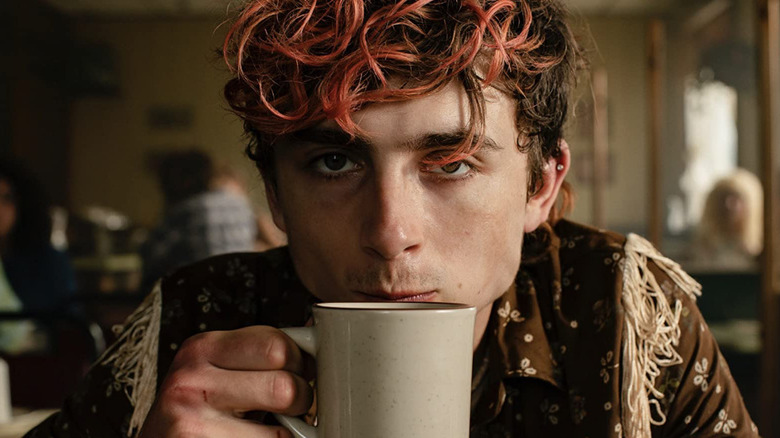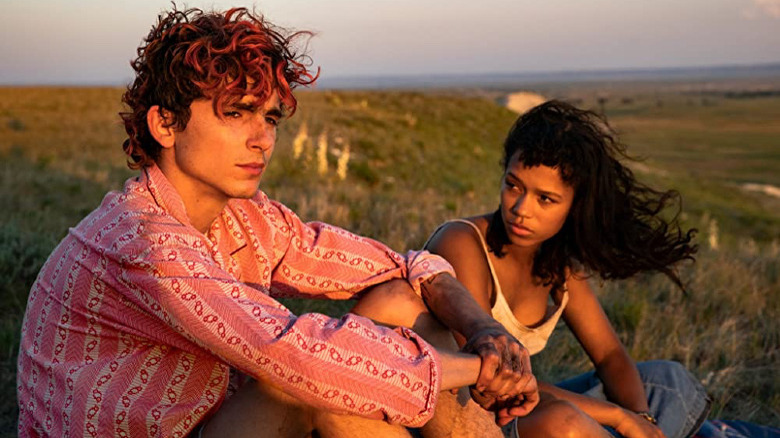Timothée Chalamet Explains The Cannibalism At The Center Of Bones & All
Italian filmmaker Luca Guadagnino has oscillated between the coming-of-age romance and horror genres for the last several years, so it was really only a matter of time before he merged those interests. "Bones and All," his latest directorial effort, does just that. Adapted from Camille DeAngelis' 2015 novel of the same name, the movie pairs Guadagnino with his "Call Me By Your Name" star Timothée Chalamet and Taylor Russell ("Escape Room," "Lost in Space") for a story about a pair of social outcasts who steadily fall deeper in love as they travel across Reagan-era America.
Oh, and did I mention they're both cannibals? That's the crux of the conflict in "Bones and All" and the reason why young lovebirds Lee (Chalamet) and Maren (Russell) are forced to live off the grid in the first place, bringing them face-to-face with all manner of dangers on the back roads and rural areas of the U.S. It's an... unusual situation, but one that could be read as an analogy for a number of issues that lovers who aren't inclined to eat people have to deal with.
In an interview with SFX (via GamesRadar+), Chalamet gave his two cents on how he interprets the cannibalism aspect of the film. "For me, it felt like the cannibalism was a metaphor for what your ancestors leave you with — your immediate parents, but also the trauma that you've lived with from generations past," he explained. "You wrestle with that. Sometimes it's something you can actually overcome and break the cycle. And sometimes a curse remains a curse and a blemish remains a blemish."
A metaphor with multiple potential meanings
Over the course of filming "Bones and All," however, Chalamet developed an alternate reading of the story's subtext. "During, it felt like [cannibalism] quickly became a metaphor about addiction for me," he explained, particularly when it comes to young adults who are dealing with addiction while trying to figure out who they are and what it even means to be in a healthy, loving, grown-up relationship. "You are wrestling with something so intense, so dangerous, as to affect other people's mortality or your own," he added.
Ultimately, Chalamet feels the movie paints a complicated portrait of romantic love as a thing that "can lift you, ultimately to sort of crush you too, because sometimes those demons remain." Marshall Shaffer, who reviewed "Bones and All" for /Film at the Venice International Film Festival, had a different take on the relationship between Lee and Maren than either of these explanations from Chalamet:
There are any number of ways to unpack "Bones and All," but the one that jumps out most immediately is a queer reading of the film's themes. (It should be obvious, but this does not mean establishing some kind of equivalency between cannibalism and queerness.) Guadagnino's consistent subversion of gendered expectation, presentation, and attraction suggests a larger commentary within his untidy allegory.
Tellingly, Guadagnino's previous horror film with his "Bones and All" scribe David Kajganich, 2018's "Suspiria," was also an allegory with multiple different potential meanings, depending on how one approached it. Any movie that offers that type of food for thought (phrasing, I know, but stay with me) is certainly one that merits a look, if only so one can add their own reading to the pile.
"Bones and All" opens in theaters on November 18, 2022.

